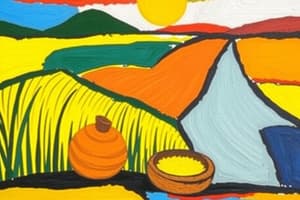Podcast
Questions and Answers
What percentage of the Philippines' caloric intake is accounted for by rice?
What percentage of the Philippines' caloric intake is accounted for by rice?
- 90%
- 80% (correct)
- 60%
- 70%
Which rank does the Philippines hold globally in terms of total rice production?
Which rank does the Philippines hold globally in terms of total rice production?
- Tenth
- Fifth (correct)
- Second
- First
Which sustainable farming practice is the Responsible Rice Agriculture (RRA) program focusing on?
Which sustainable farming practice is the Responsible Rice Agriculture (RRA) program focusing on?
- Pesticide-intensive farming
- Integrated nutrient management (correct)
- GMO seed development
- Monoculture farming
What type of livestock production significantly contributes to the Philippine economy?
What type of livestock production significantly contributes to the Philippine economy?
Which agricultural policy aims to address low yields and high production costs in the rice industry?
Which agricultural policy aims to address low yields and high production costs in the rice industry?
Flashcards are hidden until you start studying
Study Notes
Philippine Agricultural Resources
Rice Production
Rice is a staple food in the Philippines, accounting for approximately 80% of the country's caloric intake. The Philippines ranks fourth globally in terms of total rice area, fifth in terms of total rice production, and seventh in terms of rice yield. In 2022, the country produced 17.9 million metric tons of rice, up by 1.9 million metric tons compared to 2021.
Sustainable Farming Practices
The Department of Agriculture (DA) implemented the Rice Competitiveness Enhancement Fund (RCEF) to address issues in the rice industry, such as low yields and high production costs. The RCEF supports modernization programs like the Responsible Rice Agriculture (RRA), which focuses on sustainable farming practices like integrated nutrient management and irrigation systems to increase productivity while reducing chemical inputs. Additionally, the DA's Rice Technology Learning Sessions (RTLS) provide farmers with technical knowledge and skills training for sustainable rice cultivation.
Crops and Livestock
Major agricultural products in the Philippines include rice, coconuts, corn, sugarcane, bananas, pineapples, and mangoes. Crop production has been affected by factors such as natural calamities, pests, diseases, and low government support resources. The country's livestock industry contributes significantly to its economy, particularly in chicken broiler production and hog farming.
Agricultural Policies
The Philippine agricultural sector faces challenges related to low productivity, high production costs, lack of access to markets, and limited access to financial services. To address these issues, the Philippine Rural Development Project (PRDP) was implemented, focusing on increasing rural incomes and raising agricultural productivity through modern technologies, better extension services, e-commerce platforms, and agribusiness startups.
In addition, the Department of Agriculture launched the OneDA Reform Agenda, which focuses on four pillars: market development, service delivery, institutional development, and social protection. This agenda aims to improve access to services for farmers and fisherfolk, enhance agricultural productivity, and ensure food security.
Studying That Suits You
Use AI to generate personalized quizzes and flashcards to suit your learning preferences.




